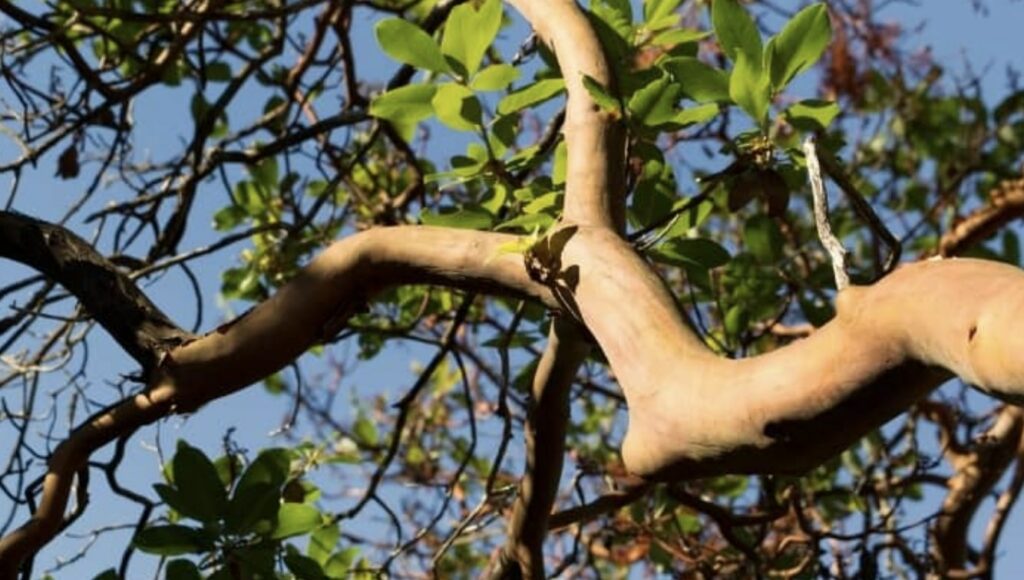
Tree barks are the most prominent part of the tree and they vary in texture. Some are smooth, making it difficult for predators and parasites to penetrate the tree.
Trees with smooth bark have white paper-thin and onion-like layers that prevent insects and pests to grip the surface and penetrate the tree. They thrive in damp and tropical environments where pests usually grow.
Since no one wants to be “barking” up the wrong tree, here is a comprehensive guide to some popular trees with smooth bark in case you happen to actually have one in your garden.
13 Trees with Smooth Bark
1. Birch Tree
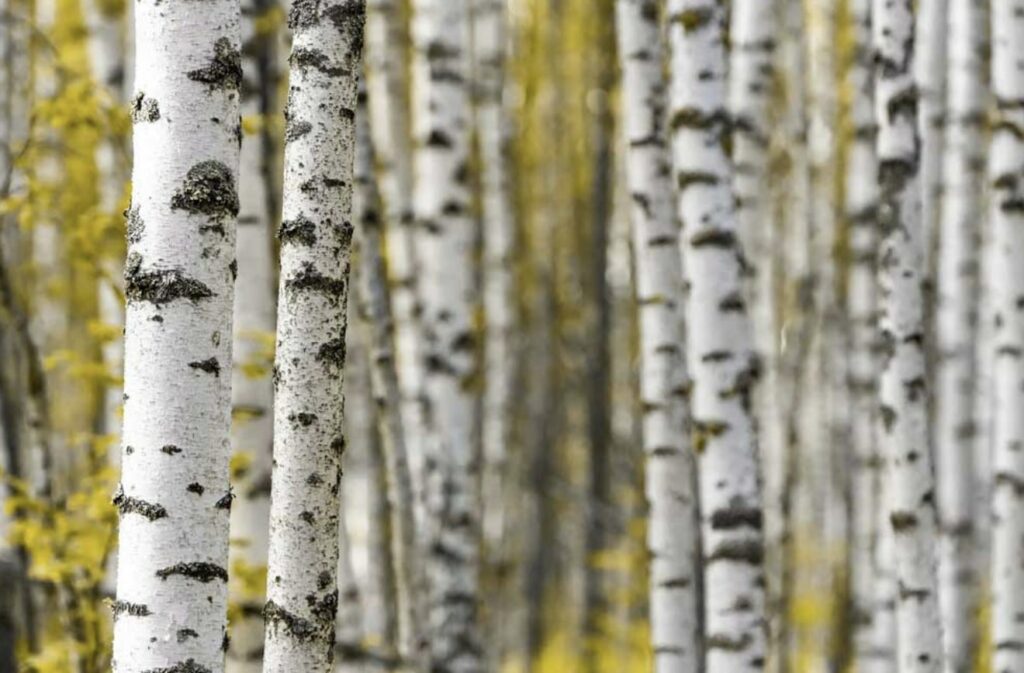
| Scientific Name | Betula pendula |
| Genus | Betulaceae |
| Bark | Smooth white paper-like texture with dark horizontal streaks Peels in narrow strips |
| Branches | Slim, Conical, and Arching |
| Leaves | 2-3 inches long Ovular, Triangular with Pointed TipsSerrated edges. |
| Fall Foliage | Turns from medium green to warm yellow, orange, and red tones |
| Height | Can grow up to 70 feet tall with canopies up to 60 feet wide |
Birch trees are deciduous trees native to North America. They thrive in temperate climates of woodlands, riverbanks, and mountainsides.
Birch tree bark contains “lenticels,” the dark horizontal streaks that aid in the exchange of gas from the internal tissues of the tree to the external environment.
The bark of birch trees has a smooth white paper-like texture. These naturally peel to shed away fungus, moss, and lichen that grow on it.
Another distinct feature is the leaves of a birch tree, which are either oval or triangular with pointed tips and serrated margins. They are alternately arranged on their branches, changing colors seasonally in shades of red, orange, or yellow.
Birch trees also produce “catkins,” which are cylindrical flower clusters that blossom during the spring season.
These trees can grow up to 70 feet tall with canopies up to 60 feet wide.
Apart from being a food source, birch tree bark is largely used for pharmaceuticals. It contains betulinic acid which is an organic ingredient in making painkillers.
2. Aspen Tree
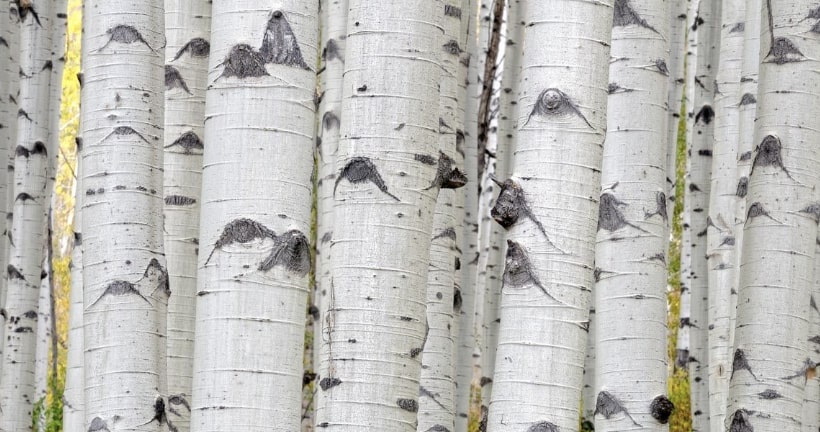
| Scientific Name | Populus tremuloides |
| Genus | Populus |
| Bark | Smooth Pale to greenish gray color Diamond-shapes lenticels |
| Branches | Slender Top branches bend horizontally |
| Leaves | Round shaped with serrated edges 0.9 to 2 inches long |
| Fall Foliage | Turns from deep green to yellow or red shade |
| Height | Reaches 20 to 80 feet high |
Aspen trees are native to cold-climate areas in the northern hemisphere such as Alaska and Canada. They grow up to 80 feet tall and 30 feet wide.
Aspen trees have straight, long and smooth trunks. The barks of aspen trees usually begin with green or yellow hues and then, later on, a silver hue.
The green hues present in the bark come from chlorophyll, making its bark photosynthetic.
Another key feature of an aspen tree is its flowers and seeds, which form into a ball of cotton wool that is released once the catkin pods are opened.
The bark of aspen trees also serves as food for butterflies, moose, and other insects and animals.
3. Beech Tree
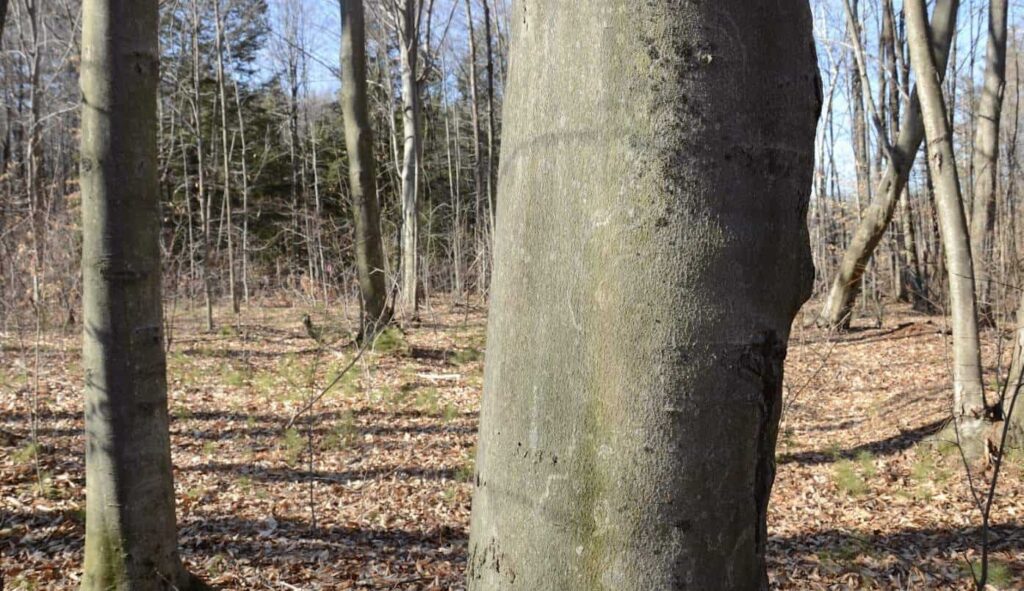
| Scientific Name | Fagus grandifolia |
| Genus | Fagaceae |
| Bark | Smooth with shallow ridges forming horizontally |
| Branches | Pyramid habit with a single trunk |
| Leaves | Elliptical leaves with pointed tips and parallel veins6 inches long |
| Fall Foliage | Turns from dark green to yellow, orange, copper shades |
| Height | Grows from 60 to 80 feet high |
Beech trees are another example of deciduous trees that grow in temperate climates. They are found in Asia, Europe, and North America.
The bark of a beech tree is smooth and light gray, and it stays like this even as it grows old. They can expand up to 70 feet tall and 40 feet wide.
Beech tree leaves have an elliptical shape and toothed leaf margins and are arranged alternately on their branches.
However, the American beech tree is prone to be infected with the naginata fungus, which leads to the beech bark disease. This occurs when insects feed on the outer bark, which reduces the natural immunity of the tree against fungus and insect attacks.
Beech tree bark can also be used as a treatment for skin diseases and as an antiseptic.
4. Paperbark Maple Tree
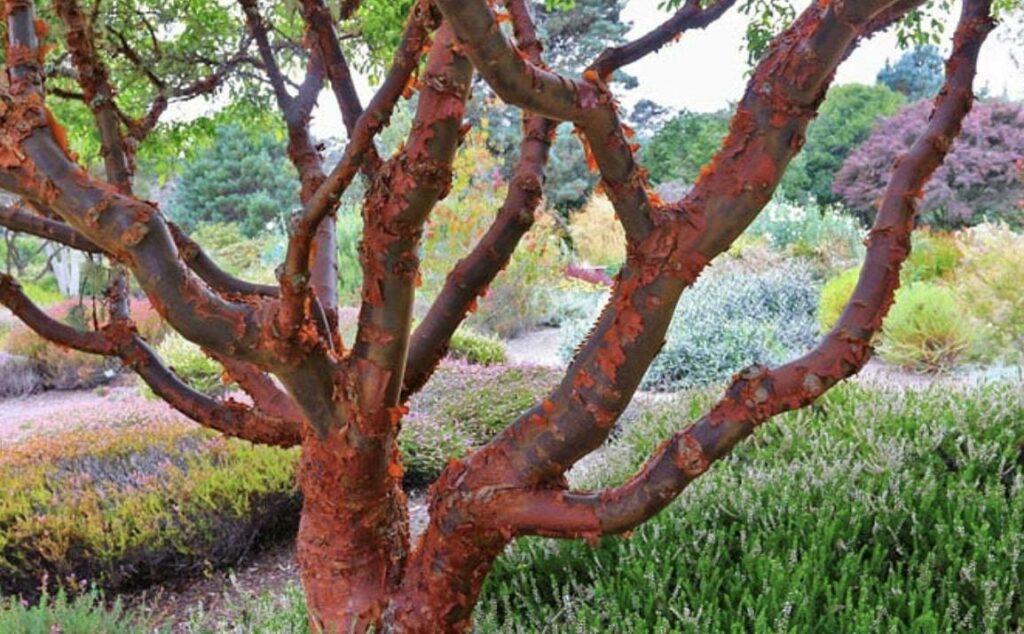
| Scientific Name | Acer griseum |
| Genus | Acer |
| Bark | Smooth bark Chesnut-brown, orange or cinnamon in color Peels in paper curls exposing a rose or tan bark underneath |
| Branches | Rounded, slender and upward growing |
| Leaves | Three-lobed with toothed edgesBluish-green underside3 to 6 inches long |
| Fall Foliage | Turns to red or orange shade |
| Height | Grows from 20 up to 30 feet high |
Paperbark maple trees are usually found in the moist and sheltered environment of Chinese provinces like Shaanxi, Shanxi, Sichuan, Gansu, Henan, Hubei, and Hunan. They grow from 20 to 30 feet tall.
The bark of a paperbark maple tree can either be brown, cinnamon, or orange. It peels in paper curls that show the rose-colored bark beneath it.
Paperbark maple leaves, on the other hand, are three-lobed with toothed edges and a blue-green undertone.
5. Japanese Stewartia Tree
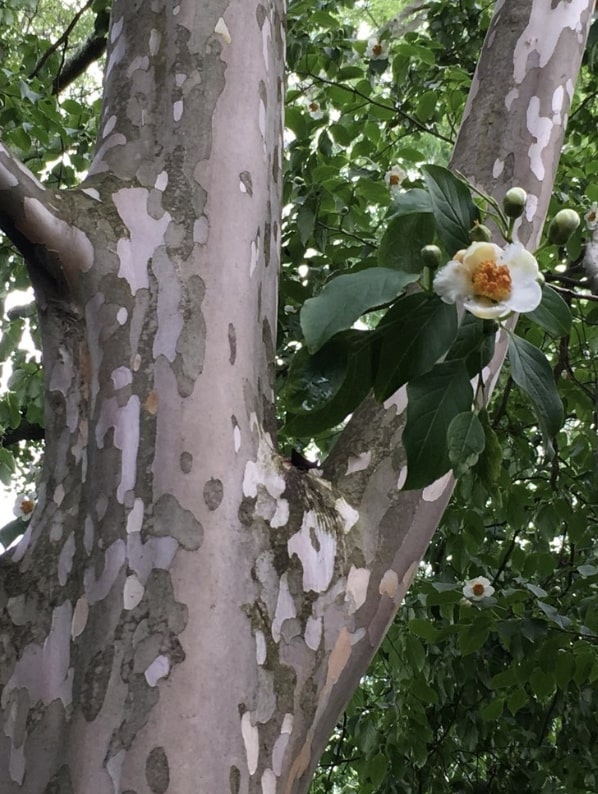
| Scientific Name | Stewartia pseudocamellia |
| Genus | Stewartia |
| Bark | Pale gray in color Exposes underlying charcoal gray, reddish brown and orange shape patchwork after exfoliation in the fall |
| Branches | Airy, pyramid habit Semi-weeping branches |
| Leaves | Dark green with oval shape and pointed tips 2 inches long |
| Fall Foliage | Turns to burgundy, orange, red hues |
| Height | Grows around 12 to 40 feet high |
Japanese stewartias are small deciduous trees that grow in moist and shaded woodlands or mountain regions of the Japanese and Korean peninsula. They can grow up to 40 feet tall.
The bark of a Japanese stewartia tree is gray. The inner bark remains smooth through regular exfoliation.
It sheds in the fall, which exposes the underlying patterns of gray, brown, and orange patches underneath.
Japanese stewartia tree leaves are oval with pointed tips usually 2 inches long. In early summer, they produce cup-shaped flowers with five white petals and yellow anthers.
6. Japanese Clethra Tree
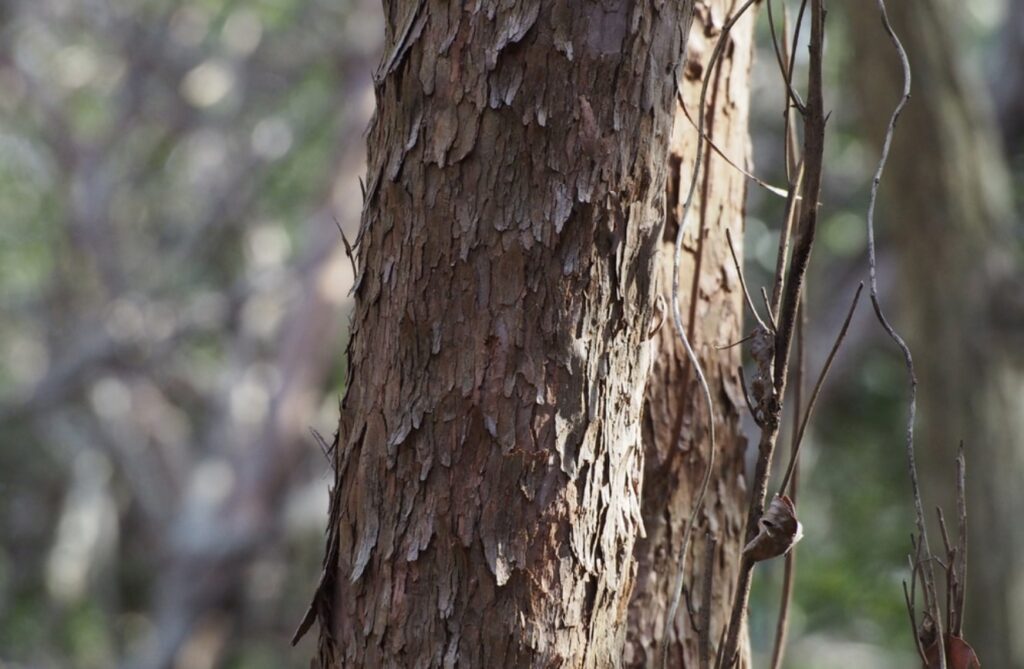
| Scientific Name | Clethra barbinervis |
| Genus | Clethra |
| Bark | Smooth, shiny bark Grayish-brown or cinnamon in color Exposes patchwork of salmon pink, lavender, cream, and gray after exfoliation in winter |
| Branches | Soft, triangular habit Upright branches |
| Leaves | Glossy, oval leaves with fine-toothed edges 2 to 6 inches long |
| Fall Foliage | Turns to bright golden yellow or red hues |
| Height | Grows from 9 to 20 feet tall |
Japanese clethra trees are usually found in high-altitude places, mountain forests, and wood hills of eastern Asia. They can grow from 9 to 20 feet tall.
The smooth bark of a Japanese clethra tree is grayish-brown in color.
It also exfoliates naturally during winter which exposes the underlying patches in pink, gray, cream, and lavender colors.
As they bloom in the summer, Japanese clethra trees produce a long white and fragrant flowers in horizontal clusters.
7. Hornbeam Tree
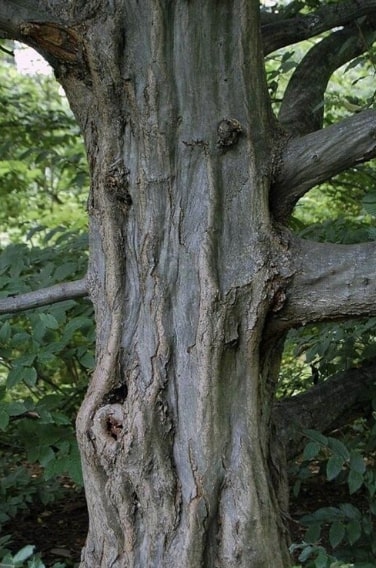
| Scientific Name | Carpinus betulus |
| Genus | Carpinus |
| Bark | Bluish gray in color Develops vertical deep furrows and flared ridges |
| Branches | Short trunk Slightly-crooked branches Oval-shaped canopies |
| Leaves | Ridged veins and serrated edges 2 to 4 inches long |
| Fall Foliage | Turns from dark green to golden yellow, red or orange leaves |
| Height | Grows between 20 to 30 feet long |
Hornbeam trees usually grow in the forest and woodland areas of eastern United States and southern Canada. They have dense canopies, with a short trunk that resembles crooked branches.
The bark of a Hornbeam Tree begins with a grayish-brown color and turns into bluish gray as it matures. It also develops vertical flared ridges and deep furrows.
Hornbeam trees grow up to 20 to 30 feet tall and produce pendulous green or reddish-brown flower spike clusters.
8. Mexican Sycamore Tree
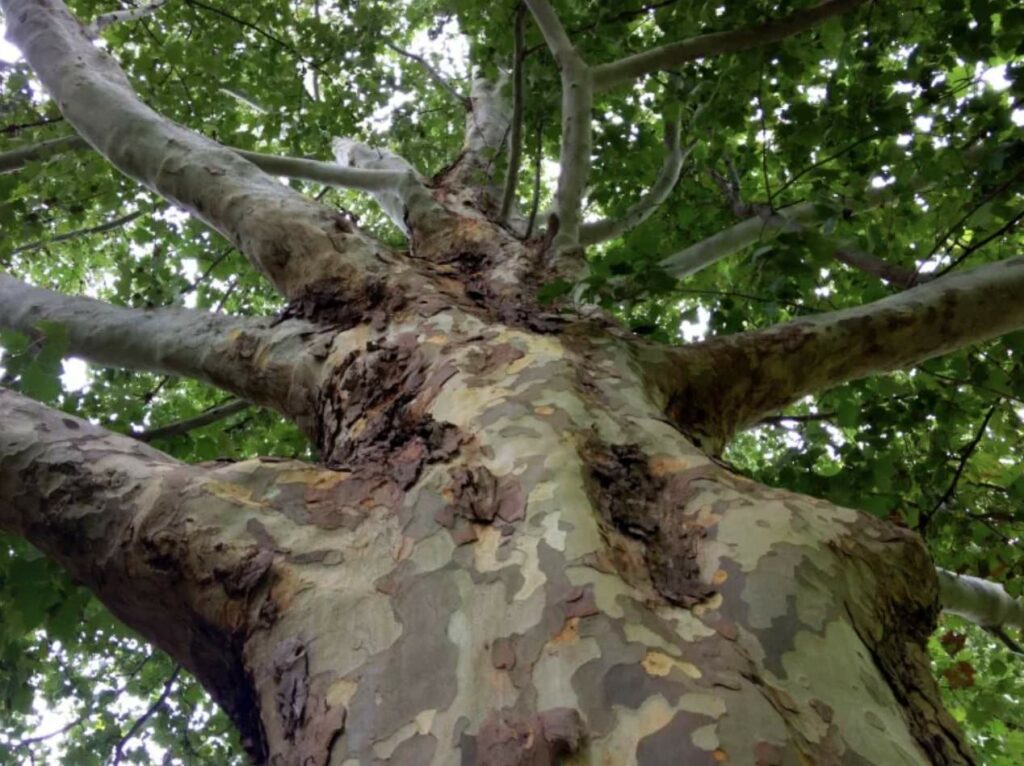
| Scientific Name | Platanus mexicana |
| Genus | Plantanus |
| Bark | Begins in light brown or white color Exposes a light cream patchwork after it exfoliates |
| Branches | Round, bushy habit Stout trunk base, around 2 meters in diameter |
| Leaves | Olive green with silver underside leaves 8-inch wide Resembles the shape of the Canadian maple leaf |
| Fall Foliage | Turns to golden yellow leaves in the fall |
| Height | Grows around 40 to 80 feet tall |
Mexican sycamores are a type of deciduous tree, native to the tropical forests and streams of northeastern and central Mexico.
The bark of Mexican Sycamore trees is light brown to white. Once the tree matures, it peels away in patchwork strips and exposes the light-cream layer underneath.
Mexican Sycamore trees have trunk bases, usually around 2 meters in diameter but can expand up to 30 feet wide.
They tend to grow from 40 to 80 feet tall and produce green flowers that dangle on their branches.
They have wide olive green leaves with silver undersides that resemble the shape of the Canadian maple leaf.
9. Eucalyptus Tree
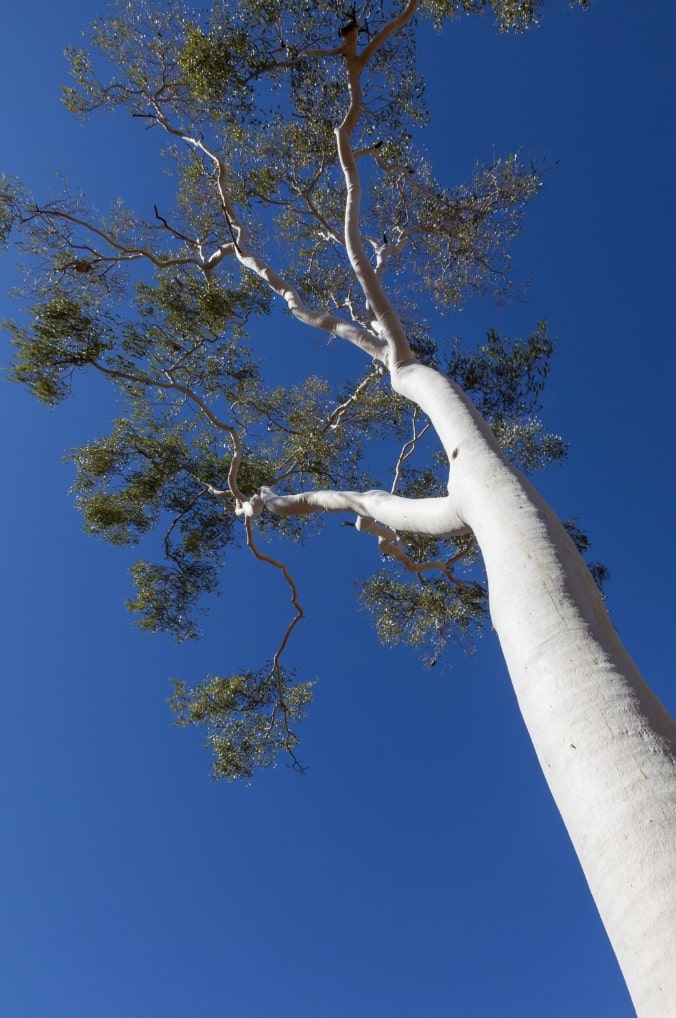
| Scientific Name | Eucalyptus sheathiana |
| Genus | Eucalyptus |
| Bark | Light gray or white in color Peels off in ribbon curls Has orange, tan or white layers underneath |
| Branches | Single trunk with steep branches Crown canopy creating an airy shape |
| Leaves | Narrow, lance-shaped leaves |
| Fall Foliage | Leaves turn to copper, burgundy or purple in the fall or winter |
| Height | Grows from 9 up to 49 feet high |
Eucalyptus trees are native to Australia. Its leaves are known as koala bear snacks, while its leaves possess the scent of eucalyptus oil.
From the diverse species of Eucalyptus trees, the ghost gum, spinning gum, white gum, and spinning gum trees all stand out for having smooth bone-white barks.
From their name, these Eucalyptus tree variations produce gum from their bark.
Eucalyptus trees of this kind also shed long ribbon curls annually. This natural process called “exfoliating bark” enables the Eucalyptus tree to cleanse itself from the parasites, fungi, or moss that grow on its bark.
With the loss of these parasites through peeling, the tree can facilitate the process of photosynthesis and allow for more light to the tree to increase its lifespan.
10. Desert Ironwood Tree
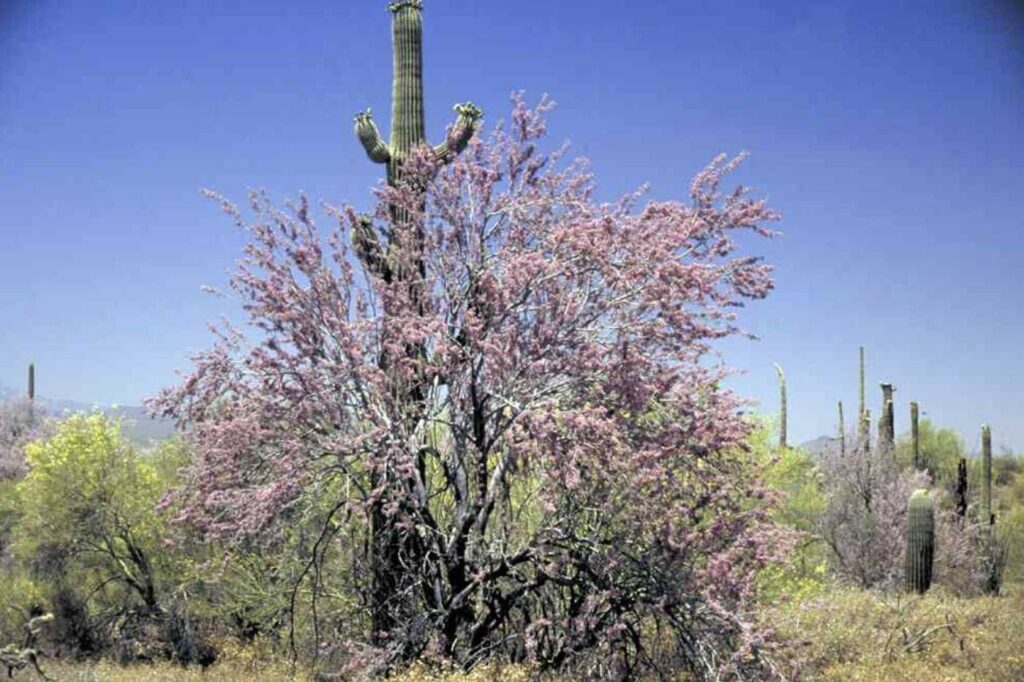
| Scientific Name | Olneya tesota |
| Genus | Fabaceae |
| Bark | Smooth, iron-gray in color Develops fissures that grow horizontally |
| Branches | Multi-trunk habit Wide-spreading branches Canopies reach up to 30 feet |
| Leaves | Each finger of the foliage holds small rounded leaves0.7 to 2.5 centimeters in diameter |
| Fall Foliage | Turns to gray-green in color with tiny sharp hairs |
| Height | Grows from 20 to 50 feet tall |
The Desert Ironwood tree is unique to the Sonoran desert.
The bark of the Desert Ironwood tree is smooth in gray color. Its bark would gradually develop horizontal fissures where sharp horns sprout.
It is believed to be one of the oldest living trees in the world. Desert Ironwood trees can live up to 1,600 years due to the fissures in their bark that naturally crack as the tree grows.
Looking at its bark color, one can easily tell if an Ironwood tree is old when its bark turns to a brownish-gray tint.
Desert Ironwood trees are easily recognizable due to their elliptical leaves and white and purple colored flowers.
Its wood has an extremely high density, making it one of the heaviest in the world. Iron Wood is regularly used for buildings and firewood.
Desert Ironwood trees are also called nurse plants as they protect cacti and other plants from the sun and frost.
Desert Ironwood bark has also been used to help cope with vomiting while its flowers are utilized for anti-inflammatory purposes and for curing hemorrhoids.
11. Ash Tree
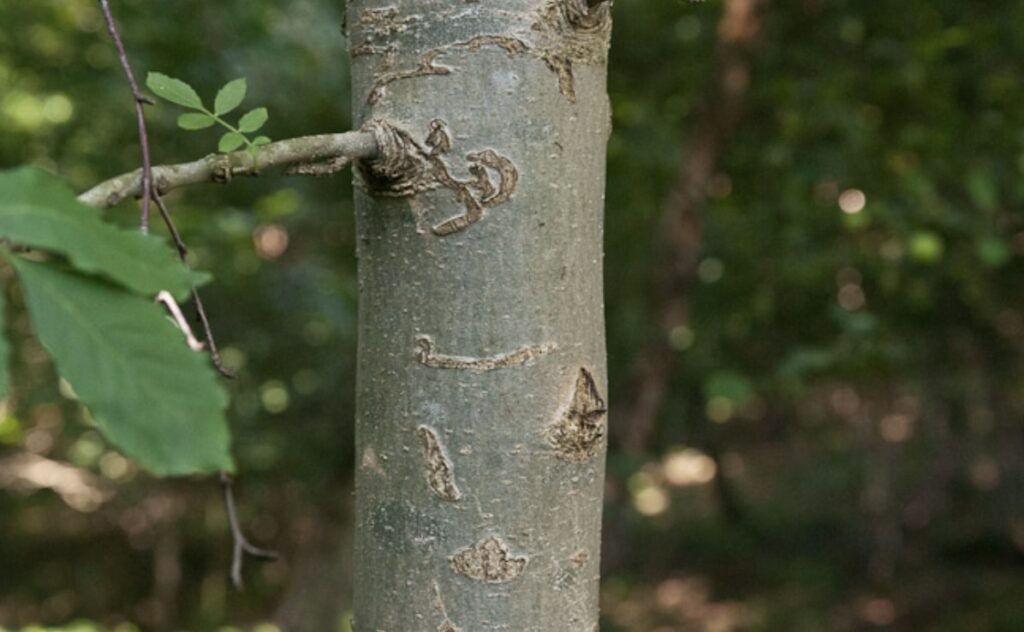
| Scientific Name | Fraxinus americana |
| Genus | Fraxinus |
| Bark | Grayish-brown with deep fissures and ridges vertically |
| Branches | 1-meter wide trunk Oval habit Branches and shoots are curved with an upward growth |
| Leaves | Deep green in color with oval, toothed edges 8 to 12 inches long |
| Fall Foliage | Turns to golden yellow leaves in the fall |
| Height | Grows around 30 to 50 feet tall |
Ash trees are native to the woodlands and streams of eastern United States. They can grow from 30 to 50 feet high.
The bark of an Ash tree begins with smooth and pale gray color. As it ages, fissures, ridges, knots, and lumps appear vertically along the tree, and the bark turns grayish-brown.
Ash trees produce clusters of feathery white and purple flowers when it reaches around 30 years old.
Ash trees are vital to wildlife as they provided food and shelter to squirrels, turkey, and even mice.
12. Red Maple Tree

| Scientific Name | Acer rubrum |
| Genus | Acer |
| Bark | Smooth, pale gray bark Develops vertical ridges |
| Branches | Pyramid-like habit that turns into a rounded canopy Twigs are green and glossy |
| Leaves | Classic maple leaf shape with five lobes 2 to 5 inches wide |
| Fall Foliage | Turns to bright burgundy, red, orange or yellow in the fall |
| Height | Grows from 60 to 90 feet tall |
Red maple trees grow in the dry ridges, swamplands and deciduous forests of Asia, Europe, northern Africa, and North America. They grow between 60 to 90 feet high.
The bark of Red Maple trees starts with a smooth and pale gray color.
Its bark is splintered into plate formations, making it easy to spot the age of a red maple tree. They, later on, develop rough vertical ridges that peel off the rough flakes.
Unfortunately, they lose their smooth texture over time. Older red maple trees usually have a darker color and rougher bark due to the cracks.
They produce dense clusters of golden red flowers and wide leaves with five lobes in the classic maple leaf shape.
Red maple bark is used as an analgesic, for the treatment of eye cataracts and even diarrhea.
13. Plane Trees
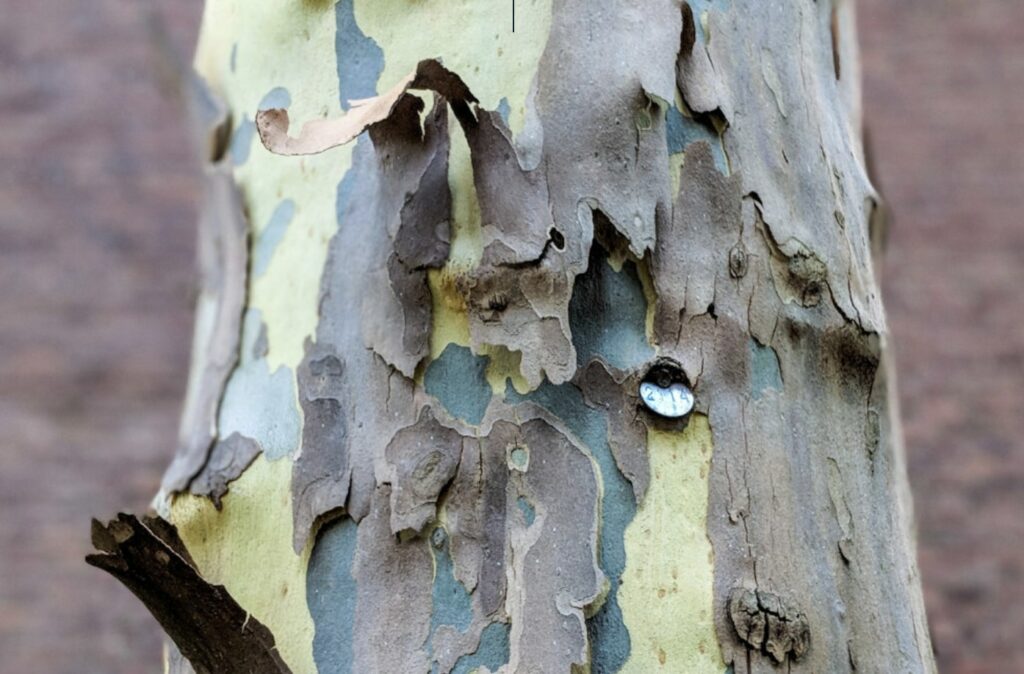
| Scientific Name | Plantanus acerifolia |
| Genus | Platanacaea |
| Bark | Smooth light brown bark Peels off to patches of white, gray, brown and tan underneath |
| Branches | Upright stem with broad-spreading branches |
| Leaves | Palmate and lobed shaped Toothed edges with prominent veins 10 to 25 centimeters across |
| Fall Foliage | Turns to yellow-brown hues in the fall |
| Height | Gros from 98 to 164 feet high |
Plane trees are found in North America, Asia, and East Europe.
Common examples of plane trees are the Oriental plane, London plane, Western sycamore, and American sycamore trees.
The smooth bark of the plane tree is known for its camouflage expression. Its smooth bark peels its white, gray, and brown patches to expose the underneath layers.
Plane trees grow from 98 to 164 feet tall. They increase in height by several feet a year, making them one of the fastest-growing trees in the world.
Due to its fast-growing characteristic, the plane trees’ bark peels as it grows taller and its layers continue to thicken.
Plane tree leaves are either three-lobed or five-lobed with toothed edges.
On the other hand, American sycamore trees are known for their seed balls. The tree produces a ball-shaped cluster of seeds that drop on the ground during the spring season.
Sycamore tree bark has been used to make teas for treating colds, coughs, and tuberculosis.
Frequently Asked Questions
A smooth bark pertains to the flat, paper-thin, and onion-like bark that covers the tree. They usually grow in damp and tropical environments and protect trees from insect and pest infestation.
Plants have smooth bark as an anatomical defense against pests, insects, and epiphytes that grip and penetrate the tree. Smooth bark also helps water flow down the roots easily such as in rainforest trees.
Here are 7 common tree barks and examples:
⮕Peeling in curvy horizontal strips – Birch, River birch (Betula nigra), Yellow birch, and American sycamore trees
⮕Visible lenticels – Big tooth aspen and Black birch trees.
⮕Smooth barks – Red maple and Beech trees
⮕Vertical cracks – Hickory, Scarlet oak, and Shagbark hickory trees
⮕Vertical strips – Pignut hickory and mature Shagbark hickory trees
⮕Broken into plates or scales – Black cherry trees
⮕Ridges and furrows –Pitch pine and Northern red oak trees.
The bark of a tree becomes rough due to the pressure caused by growth such as the breaking and tearing off its exterior layer. It also becomes rough due to harsh wind, rain, and other environmental conditions.
The barks of rainforest trees are smooth to prevent the growth of parasites, fungi, and other plants on the bark.
Unlike thick barks in temperate forests, moisture and humidity are not a problem in rainforests so most trees that grow have thin and smooth barks.
Conclusion
Smooth barks are a vital line of defense of trees against pests and harsh environmental conditions.
With this guide, you can now appreciate the distinct features of various smooth bark trees and easily identify them. Feel free to share with us photos of the smooth bark trees that you will see in the future!




